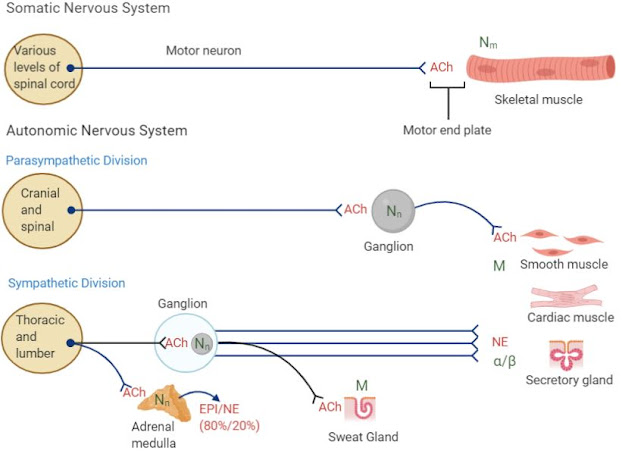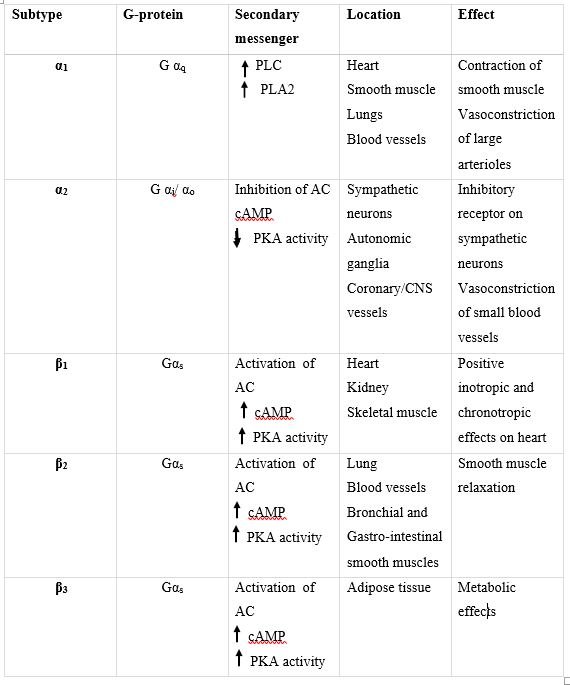Autonomic Nervous System
Differences between Somatic Nervous System (SNS) and Autonomic Nervous System (ANS)
The fig.1 provide the basic information about the arrangements of neurons with respect to the tissues in SNS and ANS
Cholinergic transmission
The synthesis, storage, and release of ACh follow a similar life cycle in all cholinergic synapses i.e.,
Skeletal neuromuscular junctions (motor end plate)
Pre-ganglionic sympathetic and parasympathetic terminals
Post-ganglionic parasympathetic varicosities
Two enzymes, choline acetyltransferase(ChAT) and acetylcholinesterase (AChE) are involved in ACh synthesis and hydrolysis, respectively.
ChAT catalyzes the acetylation of choline with acetyl coenzyme A (CoA).
Following the synthesis of ACh in the cytoplasm of cholinergic neurons, ACh is transported into synaptic vesicles by vesicular ACh transporter (VAChT) via a proton electrochemical gradient.
Upon depolarization of the nerve terminal, the release of ACh occurs via exocytosis. Depolarization allows the entry of Ca2+ into the cytoplasm which promotes the fusion of the vesicular membrane with the plasma membrane for exocytosis to occur.
Once ACh is released from the cholinergic neurons, ACh is hydrolyzed by AChE to acetate and choline.
The availability of choline is crucial for the synthesis of ACh and choline is provided from the diet.
Choline is taken up from the extracellular space by two transport systems
a. Na+ independent transport system
b. Na+ and Cl- dependent choline transport system (responsible for providing choline for ACh synthesis in neurons)
Choline is recycled after re-uptake into the nerve terminal of cholinergic cells and reused for ACh synthesis.
Cholinergic receptors and signal transduction
There are two broad categorize of the cholinergic receptors
a. Nicotinic receptor (N)
b. Muscarinic receptor (M)
Nicotinic receptor (N)
The action of ACh specific to nicotinic receptors can be obtained by using nicotine alkaloid
The nicotinic receptors are ligand-gated ion channels.
Nicotinic receptors are further subdivided as
1. Muscle type (Nm)
Found in vertebrate skeletal muscles
2. Neuronal type (Nn)
Found in autonomic ganglia the CNS and in non-neuronal tissues
Muscarinic receptor (M)
Muscarinic receptors can interact with muscarine alkaloid and responses similar to ACh can be obtained by muscarine in these receptors
Muscarinic receptors are G protein coupled receptors (GPCRs).
Muscarinic receptors are further subdivided as
1. M1
2. M2
3. M3
4. M4
5. M5
The M1, M3, and M5 sub-types works through the activation of phospholipase C (PLC) via Gq/11. This results in the hydrolysis of membrane phosphatidylinositol 4,5 diphophate (PIP2) to form Inositol triphosphate(IP3) and Diacylglycerol (DAG).
IP3 causes release of intracellular Ca2+ and results in contraction and secretion from glands.
Whereas, DAG activates Protein kinase C (PKC) which leads to the phosphorylation of various proteins and results in various physiological responses.
The M2 and M4 receptos interact with other G proteins (Gi and Go) that causes inhibition of adenylyl cyclase(AC) and resulting in the decrease of cyclic AMP (cAMP), activation of inwardly rectifying K+ channel, and inhibition of volatage-gated Ca2+ channel.
The physiological effects are hyperpolarisation and inhibition of membrane excitation.
Table 2: Different receptors of cholinnergic system
Adrenergic Transmission
Under this category, following are the neurotransmitters.
Norepinephrine (NE) in most sympathetic post-ganglionic neurons
Dopamine (DA) in mammalian extrapyramidal system, several mesocortical and mesolimbic neuronal pathyways
Epinephrine, major hormone of adrenal medulla
Collectivey, NE, DA and epinephrine are known as catecholamines
Catecholamines are stored in vesicles and opening of voltage-gated Ca2+ channels results in the release of these catecholamines in the synaptic cleft.
Synthesis of catecholamines
a. reuptake of NE and epinephrine into nerve terminal by NE tranporter (NET) or uptake 1
b. dilution by diffusion out of the synaptic cleft and uptake by extaneural sites by extraneuronal transporter (ENT) or uptake 2, organic cation transporter 1 (OCT1) and organic cation transporter 2 (OCT2)
After uptake, catecholamines can be metabolised or restored. Two enyzmes are significant in the initial metabolic transformation of catecholamines i.e.,
a. monoamine oxidase (MAO)
b. catechol-O-methyltransferase (COMT)
Adrenergic receptors and signal transduction
The adrenergic receptors are divided as
α adrenergic receptor
1. α1 Post-synaptic receptor
2. α2 Pre-synaptic receptor (have an inhibitory effect on NE release)
β adrenergic receptor
1. β1 adrenergic receptor (cardiac muscle)
2. β2 adrenergic receptor (smooth muscle)
3. β3 adrenergic receptor (adipose tissue)
All the adrenergic receptors are GPCRs
Table 3: Different receptors of adrenergic system
Acknowlegment: All the images were prepared in www.biorender.com
Reference:
Brunton, Laurence, B. A. Chabner, and B. C. Knollmann. "Goodman and Gilman’s the pharmacological basis of therapeutics. Twelfth." (2011): 1808.








Comments
Post a Comment